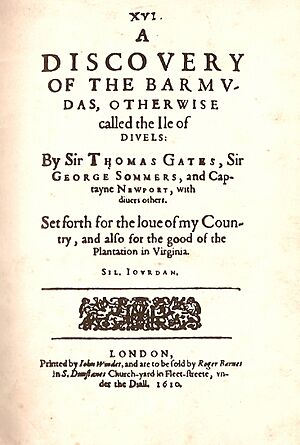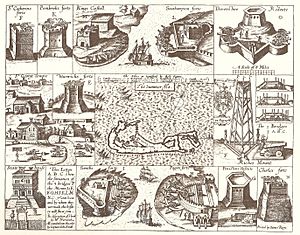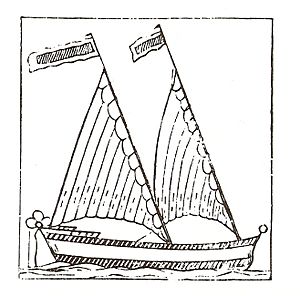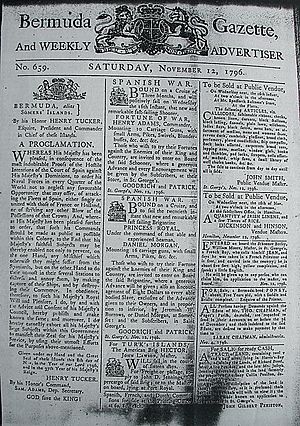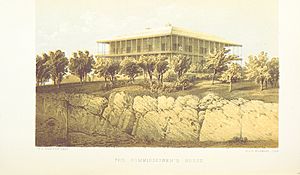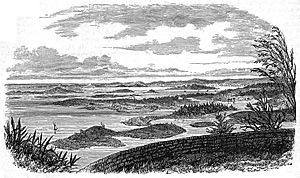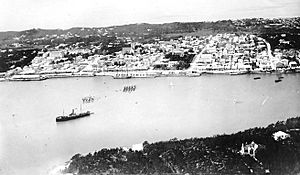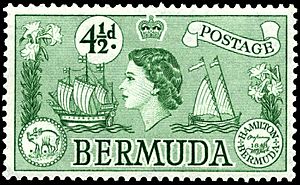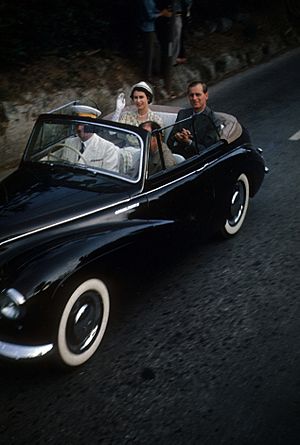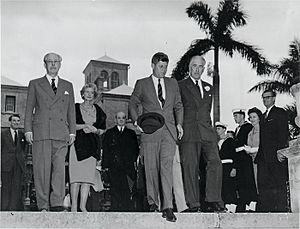History of Bermuda facts for kids
Bermuda was first found in 1503 by a Spanish explorer named Juan de Bermúdez. In 1609, an English group called the Virginia Company settled Bermuda. This happened after a hurricane forced their ship, the Sea Venture, onto a reef to stop it from sinking. Everyone on board landed safely. Bermuda's first capital city, St. George's, was started in 1612.
The Virginia Company managed the island until 1614. Then, a new company called the Somers Isles Company took over in 1615. They ran the island until 1684, when Bermuda became a direct colony of England. After England and Scotland joined to form Great Britain in 1707, Bermuda became a British Crown Colony.
When Newfoundland joined Canada in 1949, Bermuda became the oldest British colony left. It has been the most populated British territory since Hong Kong was returned to China in 1997. Bermuda officially became a "British Overseas Territory" in 2002.
Contents
How Bermuda Was Found and First Settled
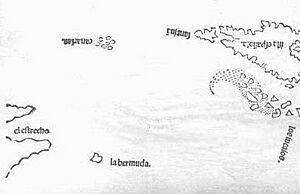
The first map showing Bermuda was made in 1511. It was called "La Bermuda." The first detailed description of the island came from Gonzalo Fernández de Oviedo y Valdés in 1515. He visited with Juan de Bermúdez. People believe the island was named after Captain Bermúdez, who discovered it.
Spanish ships often sailed near Bermuda on their way home. They used the Gulf Stream and Westerlies winds. The Spanish avoided the island because of its reefs and hurricanes. They called it "Demoniorum Insulam," meaning "Island of Devils." A rock on the island has the date 1543, but we don't know much more about it.
In 1570, a Frenchman named Russell was shipwrecked there. An Englishman, Henry May, was also shipwrecked in 1593. Both managed to escape. In 1603, Spanish Captain Diego Ramirez was stranded after a storm. He found that the "devils" people talked about were actually the cries of the Bermuda petrel bird.
In 1585, an English ship called Tiger captured a larger Spanish ship near Bermuda. This happened during a battle.
The Shipwreck of the Sea Venture in 1609
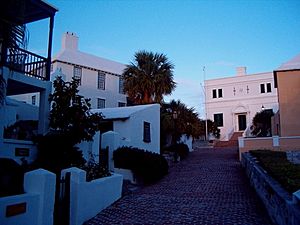
On June 2, 1609, Sir George Somers sailed on the Sea Venture. This was the main ship of the Virginia Company. It led a fleet of nine ships carrying hundreds of settlers and supplies for the new English colony of Jamestown in Virginia.
The fleet got caught in a big storm on July 24. The Sea Venture was separated and started to sink. To save everyone, the ship was purposely steered onto the reefs east of Bermuda. This saved all 150 sailors and settlers, plus one dog. Some people think William Shakespeare's play The Tempest was inspired by the story of this shipwreck.
The survivors stayed on Bermuda for nine months. They built two new ships from Bermuda cedar. One was called Deliverance and the other Patience. On May 10, most survivors sailed to Jamestown, arriving on June 8, 1610. They found that most of the Jamestown colony had died during a very hard winter.
Sir George Somers returned to Bermuda but soon died there. His heart was buried in St. George's.
Official Settlement in 1612
Two years later, in 1612, the Virginia Company's royal permission was extended to include Bermuda. Sixty settlers were sent on a ship called Plough. Sir Richard Moore was their leader and became the island's first governor.
They joined three men who had stayed behind from the Sea Venture shipwreck. Together, they started building the town of St. George. This became Bermuda's first capital. It is the oldest English town in the New World that has been lived in continuously.
For the next 70 years, Bermuda struggled to make money. The Virginia Company found the colony unprofitable. So, in 1615, King James I gave a new company, the Somers Isles Company, permission to run the colony. This company managed Bermuda until 1684. In 1620, Bermuda got its own government, the House of Assembly of Bermuda, and became a self-governing colony.
The Somers Isles Company (1615–1684)

In 1615, the colony was given to the new Somers Isles Company. It was named after Admiral Somers, who saved the Sea Venture passengers. Bermuda was divided into eight areas called "tribes" (now "parishes"). These areas were given to the main investors of the company.
The company sent 600 settlers on nine ships between 1612 and 1615. Governor Moore built forts to protect St. George's. In 1614, the first English-grown tobacco was sent out from Bermuda. The island also made a lot of money from ambergris, a valuable substance from whales.
In 1616, plants like sugarcane and pineapple were brought to Bermuda. The first enslaved Africans also arrived. By 1619, Bermuda had between 50 and 100 enslaved black people. Bermuda grew more tobacco than Virginia until 1625. But when tobacco prices dropped in 1630, Bermuda started growing other crops like corn and potatoes. Tobacco exports reached their highest point in 1684, the last year the company was in control.
By the 1620s, English immigration mostly stopped because all the land was taken. Bermuda's small size meant many people had to leave. They went to other English colonies like the Bahamas and the Carolinas.
Bermuda's limited land led to some of the earliest conservation laws in the New World. In 1616 and 1620, laws were passed to protect certain birds and young tortoises from being hunted.
English Civil War in Bermuda
In 1649, King Charles I was executed in London during the English Civil War. This caused problems in Bermuda, leading to a small civil war on the island. Most colonists were loyal to the King. Some people, like the Puritans, were forced to move to the Bahamas. However, many were later allowed to return to Bermuda.
In 1650, the English Parliament passed a law to control colonies that supported the King, including Bermuda. Trade was limited to English ships only. In 1658, a new governor was appointed for Bermuda, and the islanders promised loyalty to the new English government.
Slavery in 17th Century Bermuda
Many early settlers in Bermuda were indentured servants. They worked for a few years to pay for their journey. This meant there wasn't as much need for enslaved people to grow tobacco. However, Bermuda did have enslaved black and Indian people. They were often captured by privateers and then sold on the island.
By the 1690s, Bermuda's economy changed to focus on the sea. Enslaved people became very important as sailors, carpenters, and shipbuilders. Owners would hire out their skilled enslaved workers. By 1710, enslaved people made up a large part of Bermuda's population.
The price of an enslaved person depended on demand. Children sold for about £8, women for £10 to £20, and able-bodied men for around £26.
There were several slave revolts in Bermuda. One in 1656 led to executions and banishments. Other revolts in 1664, 1673, and 1681 were stopped early. These revolts led to strict rules. Enslaved people were not allowed to wander at night or gather in groups. Any black people thought to be free were forced to become enslaved again or leave the island. Bringing in more enslaved people was also banned.
The 18th Century
The Salt Trade and the Turks Islands
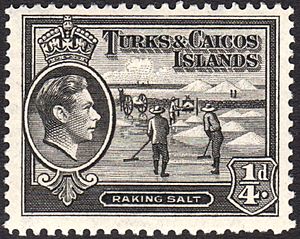
Bermudians had been collecting salt in the Caribbean since the 1630s. Salt was very important for preserving food. Salt Cay and Grand Turk Island became important salt-producing areas in the 1680s. These islands were perfect for making salt because they were hot, dry, and had little fresh water. This helped sea water evaporate quickly, leaving behind salt.
Bermudians claimed these islands because they had discovered and used them. However, France and Spain also wanted them. They attacked the islands many times, along with pirates. These attacks continued until 1764, when Great Britain officially took control.
By 1740, 200 ships were loading salt from Grand Turk and Salt Cay each year. The salt business changed from mostly white workers to a mix of enslaved and free labor.
In 1701, when a Bermudian ship was seized by people from the Bahamas, Bermuda's Governor Bennett allowed Bermudian privateers to attack enemy ships. In 1706, Spanish and French forces took over the Turks Islands. But three years later, a Bermudian privateer led by Captain Lewis Middleton drove them out.
In 1766, a Bermudian merchant named Andrew Symmer was put in charge of the Turks and Caicos Islands. He made new rules and taxes for the salt rakers. The Bahamas government also tried to take control and tax the salt. This caused conflicts between Bermuda and the Bahamas.
The Bahamas eventually took control of the Turks Islands and taxed their salt. This hurt Bermuda's salt industry. In 1806, Bermuda stopped allowing free trade with the Turks Islands. This affected many Bermudians, including enslaved people, who worked there seasonally.
In 1815, two hurricanes destroyed many buildings and salt stores on the Turks Islands. The United States, which bought most of the salt, had found other sources. Because of the storms and loss of market, many Bermudians left the Turks Islands. The British government eventually gave political control to the Bahamas.
A Bermudian salt raker named Mary Prince wrote a book about her life. Her book, The History of Mary Prince, helped the movement to end slavery throughout the British Empire in 1834.
Shipbuilding and the Maritime Economy
After the Somers Isles Company lost control in 1684, Bermuda's economy changed. It moved from growing tobacco to sea-based activities. These included building ships, salvaging shipwrecks, whaling, piloting, and fishing. By 1700, Bermuda's fleet had grown to 60 sloops and other ships.
These "Bermuda sloops" were known for their speed and ability to sail against the wind. They were built from Bermuda cedar, which was strong and light. Bermudians used both enslaved and free labor to build these ships quickly. They also planted new cedar trees to make sure there was always wood for shipbuilding.
The Bermuda sloop became very famous. The Royal Navy even used them. For example, the HMS Pickle carried news of the victory at Trafalgar and the death of Admiral Nelson to England.
Privateering
Bermuda was a hub for privateering for much of its early history. Privateers were private ships allowed by the government to attack enemy vessels. Bermudian governors encouraged this practice. Many Bermudians left farming to work as privateers on English ships.
During the 1740s, at least 15 Bermudian privateers were active. They were allowed to capture enemy ships or British ships trading illegal goods. The crews were a mix of free and enslaved people.
During the American War of Independence, Bermudian privateers aggressively attacked American ships. Americans were surprised to find that Bermudian privateer crews included enslaved black people. When one Bermudian privateer was captured, almost all its crew were enslaved black men. They were offered freedom in Boston but chose to be treated as prisoners of war so they could return to their families in Bermuda. They later seized their ship and sailed it back to Bermuda.
The American War of 1812 was the last time Bermudian privateering was very active. Bermudian privateers captured 298 ships during this war.
Bermuda and the American War of Independence
Before the American Revolution, Bermuda's sea economy faced challenges. Bermudians relied on food imports from North America. Many Bermudians moved to other places like Belize or the Bahamas.
Bermuda was not very involved in the political issues that caused protests elsewhere. The island had no newspapers and a weak local government. It often relied on smuggling.
In September 1774, the American colonies decided to stop trading with Great Britain and its colonies. This would have caused famine in Bermuda. So, Bermudian leaders met in May 1775 and decided to ask the Americans for an exception. They found a way to trade American goods for military supplies.
On August 14, 1775, 100 barrels of gunpowder were secretly taken from Bermuda's magazine and loaded onto American ships. Because of this, the Americans allowed Bermuda to trade with them. But Bermuda gained a reputation for disloyalty to Britain. Britain then sent a warship to watch over the island. Despite this, Bermudians continued to trade illegal goods.
After France joined the war in 1778, Britain strengthened Bermuda's defenses. Many French and American ships were captured, causing food shortages in Bermuda.
The war's outcome meant Britain lost its naval bases in North America. This made Bermuda very important to the Royal Navy. Its location was perfect for protecting British trade routes and watching the American coast. Bermuda's importance was shown again in the War of 1812 and the American Civil War. During the War of 1812, attacks on Washington D.C. were planned from Bermuda. During the Civil War, Bermuda was a key stop for ships secretly bringing supplies to the Southern states.
Because of the large military presence, Bermuda's own militia stopped being active after 1815. The Royal Navy's presence also reduced the need for Bermudian privateers. The American War of 1812 led the US to find other sources for salt, hurting Bermuda's salt trade. By the early 1800s, Bermuda's cedar forests were gone from shipbuilding. As ships became larger and made of metal, Bermuda's shipbuilding industry declined.
Bermuda's main economic focus became defense. Even when tourism started later in the 19th century, London still saw Bermuda as a military base first. This strengthened Bermuda's ties to Britain but reduced its independence in the world.
The 19th Century
After the American Revolution, Bermuda became very important to the Royal Navy. It was a key stop between Canada and Britain's Caribbean colonies. Hamilton, a new port founded in 1790, became the capital in 1815. This was partly because the Royal Navy had spent years mapping Bermuda's reefs to find a deep channel for ships.
In 1811, the Royal Navy began building a large dockyard on Ireland Island. This became their main naval base in the western Atlantic. To protect it, the British Army built many forts and had a large military presence.
During the War of 1812 with the United States, British attacks on Washington, D.C. were planned from Bermuda. The Royal Navy's North American headquarters had recently moved there.
In 1816, James Arnold, son of Benedict Arnold, helped fortify Bermuda's Dockyard against possible US attacks. Today, the National Museum of Bermuda is located at the Dockyard and shows its military history.
In the 1860s, the military building projects brought much-needed money to Bermuda. This was important as traditional sea industries were declining due to new steel ships and steam power. The American Civil War also briefly boosted the local economy.
During the American Civil War, ships called blockade runners often used Bermuda as a base. They brought war supplies from England to the Southern states and took cotton back to England. The old Globe Hotel in St. George's, where Confederate agents met, is now a museum.
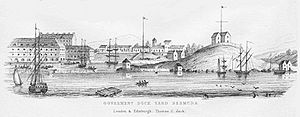
Many forts and batteries were built in the early 1800s to protect the naval base. However, there weren't enough soldiers to man all the guns. Many forts were abandoned soon after being built. After the Crimean War, Britain started reducing military forces in colonies like Bermuda. This was for economic reasons and because the Royal Navy's ships could protect the Dockyard better. Still, Bermuda's important location meant the military withdrawal was very slow, lasting until after World War I. The last regular army units left when the Dockyard closed in the 1950s.
Tourism and farming grew in the late 19th century. But defense infrastructure remained the main part of Bermuda's economy into the 20th century.
Anglo-Boer War
During the Anglo-Boer War (1899–1902), Bermuda housed about 5,000 Boer prisoners of war (POWs) on five of its islands. Some prisoners, called "Bitterenders," refused to promise loyalty to the British. They were kept on Darrell's Island under strict guard. Other islands allowed prisoners more freedom.
In June 1901, The New York Times reported that 900 Boer prisoners tried to mutiny on their way to Bermuda. Several prisoners escaped after arriving. One young soldier escaped from Darrell's Island, reached the main docks, and hid on a ship to New York. Three others escaped to mainland Bermuda.
The most famous escapee was Captain Fritz Joubert Duquesne. He was serving a life sentence for spying. On June 25, 1902, Duquesne escaped from his tent, got over a barbed wire fence, and swam 1.5 miles to the main island. He used the distant Gibbs Hill Lighthouse to guide him. From there, he escaped to St. George's and then hid on a boat to Baltimore, Maryland. He later became a spy for Germany in both World Wars.
The 20th Century
Tourism
Tourism in Bermuda began in Victorian times. Wealthy people came to escape the cold North American winters. Many also hoped their daughters would marry young officers from the military base. Local hotels held dances and events to help this happen.
Bermuda was known for having many unmarried women. This was because many Bermudian men were at sea and sometimes settled elsewhere. Many Bermudian women married naval or military officers.
Bermuda was advertised as being cooler in the summer than other resorts. In the early 20th century, as travel improved, Bermuda became a popular spot for American, Canadian, and British tourists. In 1930, a US law made it harder for Bermuda to export vegetables to the United States. This encouraged Bermuda to focus more on tourism.
The first airplane reached Bermuda in 1930. Air travel improved in 1933 when the Royal Air Force set up a station at the Royal Naval Dockyard. In 1937, Imperial Airways and Pan American World Airways started regular flying-boat services to Darrell's Island, Bermuda. Tourism really grew after World War II, when the first airport for land-based planes was built.
World Wars

Bermuda sent volunteer soldiers to fight in Europe with the British Army during World War I. They suffered many losses.
During World War II, Bermuda's importance as a military base grew. It was on a major shipping route across the Atlantic Ocean. The Royal Naval dockyard helped organize large groups of ships called convoys. The military garrison protected the island from possible enemy attacks.
From 1939, the Royal Canadian Navy worked with the British Navy to train anti-submarine forces in Bermuda. In 1940, Canada sent soldiers to help guard the island.
Bermuda also became important for secret British operations. People in Bermuda checked radio communications, mail, and passengers on flying boats crossing the Atlantic. They found secret messages and identified spies working for Germany and Italy. This information was sent to the FBI. The island also helped find German submarines and decode secret messages.
In 1941, the United States was given permission to build naval and air bases in Bermuda for 99 years. This meant the US helped secure Bermuda, freeing up British forces for other parts of the war. The US Air Force built an airfield on St. David's Island, and the Navy built a base for flying boats in the Great Sound. These joined two other air stations already in Bermuda.
Post-War History
Bermuda has done very well economically since World War II. It has become a successful place for international business. While tourism is still important, international business has been the main part of Bermuda's economy for the last 30 years.
The Royal Naval Dockyard and military garrison were important to Bermuda's economy until the mid-20th century. They provided jobs and bought supplies locally. US military bases also operated in Bermuda starting in World War II.
On September 1, 1995, both US military bases closed. British and Canadian bases also closed around the same time. The US officially returned the base lands to Bermuda in 2002.
In 1948, regular commercial flights began to Kindley Field (now L.F. Wade International Airport). This helped tourism reach its highest point in the 1960s and 1970s. By the end of the 1970s, international business became more important than tourism for Bermuda's economy.
In the 1960s, Bermuda introduced universal adult suffrage, meaning all adults could vote. A two-party political system also developed. Before this, only people who owned a certain amount of property could vote. In 1973, Bermuda's Governor Richard Sharples was killed. His execution in 1977 led to three days of riots.
Bermuda has been a self-governing colony since 1620. A formal constitution was created in 1968, giving the island more internal self-government. There has been talk about Bermuda becoming fully independent. However, in a 1995 vote, people strongly rejected independence. Many people worry that independence would mean Bermuda would have to pay for its own embassies and lose British passports, which could make travel harder. They also worry about losing the protection of the Royal Navy for Bermuda's many merchant ships.
The 21st Century
Bermuda has been hit by several strong hurricanes in the 21st century. These include Hurricane Fabian in 2003, Fay and Gonzalo in 2014, Hurricane Joaquin in 2015, and Hurricane Nicole in 2016.
Notable Historical Figures
Until 1700
- Henry Woodhouse (1573–1637) was Governor of Bermuda from 1623 to 1627.
- Philip Bell (1590–1678) was Governor of Bermuda from 1626 to 1629.
- George Starkey (1628–1665) was an alchemist and writer from Bermuda.
- John Bowen (c.1660–1704) was a pirate active during the Golden Age of Piracy.
- Sir Charles Hotham, 4th Baronet (c.1663–1723) was a British Army officer and Member of Parliament.
- Sybilla Masters (c.1676–1720) was an American inventor. She was the first person from the American colonies to get an English patent.
1700 to 1800
- St. George Tucker (1752–1827) was a lawyer and law professor in Virginia after the American Revolution.
- Hezekiah Frith (1763–1848) was a rich British ship owner and privateer.
- John Dunscombe (1777–1847) was a merchant and political figure in Newfoundland.
- Captain Charles Stuart (1783–1865) was an Anglo-Canadian who worked to end slavery.
- John R. Cocke (1788–1854) was an American politician from Virginia.
1800 to 1900
- Augustus William Harvey (1839–1903) was an industrialist and politician in Newfoundland.
- Ernest Graham Ingham (1851–1926) was an important Anglican bishop and writer.
- Mary Ewing Outerbridge (1852–1886) brought the game of lawn tennis to the US from Bermuda.
- John Smith (born 1854) was a US Navy sailor who received the Medal of Honor.
- Frank Percy Crozier (1879–1937) was a British military officer.
- Ernest Trimingham (1880–1942) was an actor from Bermuda, one of the first black actors in British cinema.
- Edgar F. Gordon (1895–1955) was a doctor, politician, and civil rights leader in Bermuda.
See also
 In Spanish: Historia de Bermudas para niños
In Spanish: Historia de Bermudas para niños



